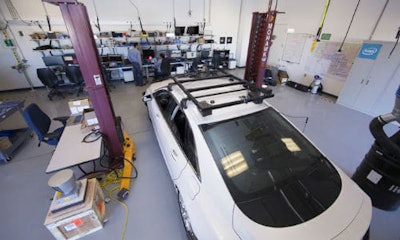
By Jeff Sanford
Toronto, Ontario — August 20, 2017 — In this week’s Autonomous Report, Ford’s new automation-focused CEO steps out, old-timers get autonomous vehicles (AVs), 3M designs sensor-friendly stop signs and much, much more!
– A press release notes that BMW Group, Intel and Mobileye have signed a memorandum of understanding with Fiat Chrysler Automobiles (FCA) to be the first automaker to join them in developing a, “… world leading, state-of-the-art autonomous driving platform for global deployment.” FCA will bring engineering, technical resources, “… as well as its significant sales volumes, geographic reach and long-time experience in North America.”
FCA CEO Sergio Marchionne was quoted as saying, “In order to advance autonomous driving technology, it is vital to form partnerships among automakers, technology providers and suppliers,”
Billions are being spent in the sector so companies need to spread and share the risk. In July 2016, BMW Group, Intel, and Mobileye announced they were combining resources to develop self-driving vehicles (Level 3) and fully automated driving (Level 4/5) into production by 2021. The cooperation remains on-track to deploy 40 autonomous test vehicles on the road by 2017 year-end.
– Ford’s new CEO, Jim Hackett, stepped out this past week at a conference to talk about how, “… the auto maker is rethinking how customers are going to want to use self-driving vehicle technology.” A big story in the Wall Street Journal covered off the appearance by Hackett, noting that Ford had previously announced a goal of having an AV ready for 2021. The CEO reiterated the goal but also said the company is reviewing how these vehicles might be best deployed. The WSJ article mused that Ford might be shifting strategy a bit when it comes to AVs.
The story quoted Hackett as saying, “The biggest leap is the nature of the human interpretation of using it. If you think we’re going to take the [autonomous vehicle] and just replace the station wagon, I don’t believe that’s what’s going to happen. The AV will replace and do something that the station wagon can’t do—not just drive itself—but other things … It’s about aligning the technology to what the market wants it to do—is it a new station wagon or is it an Uber vehicle? We have work to do.”
The story goes on to note that since taking the top job, Hackett has already “been to Silicon Valley five times” as the automaker gets set to face down the technology firms now suddenly encroaching on the traditional turf of the Big Three. To get ready for this epic battle the CEO is undertaking a “100 day review” of operations at Ford. The company will look for cost savings, but the review will also analyze, “… the importance of the infrastructure around self-driving vehicles, such as an operating system that allows everything to communicate to coordinate,” according to the report.
“There’s a marriage of the evolution of the technology of the vehicle and the evolution of the system it works in. In my 100-day review, I’m more convinced that the harmony of that is key to Ford,” Hackett was quoted as saying. We’re not exactly sure what that means, but it sounds like Ford employees are going to be busy. The previous Ford CEO had said that Ford would roll out an AV with no steering wheel by 2021, but some think Hackett is indicating a slower, more gradual approach to AVs. According to the story, “Hackett also has noted that Ford is behind in other connected-car services, such as providing customers with over-the-air updates.”
– In other Ford-related AV news, Jalopnik reports that Ford filed a new patent for a car that would feature a removable steering wheel and pedals. According to the report, “… the system would allow there to be a steering wheel for development purposes, [enabling] the easy provision of a steering wheel as a customer-requested option … A vehicle with this system would have a cabin with receiving niches for the steering wheel and pedals, and there would be locking points for securing the items into place. When not inside, trim pieces would hide the connection locations.”
A similar arrangement would apply to the pedals. Ford could use a “spring-loaded snap engagement for mounting the removable accelerator and brake pedal.” The pedals would have an electric actuator, “… operated by software programmed to simulate brake pedal resistance and restoring force.”
According to the story, “Humans are going to need time to adapt and accept robotcars into the world—roughly one-in-four people are currently skeptical of the technology—so providing an option seems like a workable idea to help increase public acceptance.”
– A report on CNBC notes that Apple filed some patents for Bluetooth sensors that can, “… help cars communicate with each other … Bluetooth short-range wireless technology, would scan the surroundings, communicating with other cars, sensors and a GPS system, updating a drivers’ dashboard display to reflect obstacles like ambulances or cars passing. The patent doesn’t describe the technology as a self-driving car, but rather, compares it to a, “… souped-up version of parking sensors blind-spot detection systems that are already commonplace in cars today.” The story goes on to say that Apple CEO Tim Cook has been investing heavily in building autonomous systems, “… and one major application of that technology is cars.”
– A great bit of AV industry gossip leaked this week. Bloomberg and other publications noted that Anthony Levandowski, the embattled former engineer of Uber, once sent an email to the one-time CEO, Travis Kalanick, urging him to, “… criticize Tesla Inc.’s Elon Musk and several of his claims about autonomous vehicles.” Levandowski is now on trial, accused of taking confidential documents with him when he left Waymo to take the job with Uber. Some emails were introduced into evidence. A text to Kalanick in September suggested, “We’ve got to start calling Elon on his sh-t. I’m not on social media but let’s start ‘faketesla’ and start give physics lessons about stupid sh-t Elon says like this.”
Levandowski also sent Kalanick a link to a video, “showing a fatal accident that the Chinese news outlet said involved Autopilot. Levandowski wrote that Musk had been lying about Tesla’s safety record and said he received the link from Ford.” As the storye notes, “Federal regulators probed a separate fatal May 2016 crash involving an Ohio man who was using Autopilot when his Tesla slammed into the side of a tractor trailer in Florida. Neither the driver nor the Autopilot system noticed the white side of the tractor-trailer against a brightly lit sky, so brakes weren’t applied, according to the company. The National Highway Traffic Safety Administration earlier this year said it didn’t find a defect with Tesla’s technology and wouldn’t issue a recall.”
– 3M is designing traffic signs with messages that are only readable by auto sensors, according to a report on Business Insider. The new auto-visible-only messages will be imprinted along with the traditional symbols. The driving infrastructure will be more easily understood by AVs, which will help the self-driving cars negotiate the environment. Colin Sultan, the head of 3M’s Connected Roads division was quoted as saying, “There’s not a lot of discussion around how infrastructure is going to help vehicles get to that Level 4 or 5 — and it will be critical.”
The Autonomous Report: FCA teamsup with BMW Group, Intel and Mobileye on self-driving tech By Jeff Sanford Toronto, Ontario — August 20, 2017 — In this week’s Autonomous Report, Ford’s new automation-focused CEO steps out, old-timers get autonomous vehicles (AVs), 3M designs sensor-friendly stop signs and much, much more! – A press release notes that BMW Group, Intel and Mobileye have signed a memorandum of understanding with Fiat Chrysler Automobiles (FCA) to be the first automaker to join them in developing a, “… world leading, state-of-the-art autonomous driving platform for global deployment.” FCA will bring engineering, technical resources, “… as well as its significant sales volumes, geographic reach and long-time experience in North America.” FCA CEO Sergio Marchionne was quoted as saying, “In order to advance autonomous driving technology, it is vital to form partnerships among automakers, technology providers and suppliers,” Billions are being spent in the sector so companies need to spread and share the risk. In July 2016, BMW Group, Intel, and Mobileye announced they were combining resources to develop self-driving vehicles (Level 3) and fully automated driving (Level 4/5) into production by 2021. The cooperation remains on-track to deploy 40 autonomous test vehicles on the road by 2017 year-end. – Ford’s new CEO, Jim Hackett, stepped out this past week at a conference to talk about how, “… the auto maker is rethinking how customers are going to want to use self-driving vehicle technology.” A big story in the Wall Street Journal covered off the appearance by Hackett, noting that Ford had previously announced a goal of having an AV ready for 2021. The CEO reiterated the goal but also said the company is reviewing how these vehicles might be best deployed. The WSJ article mused that Ford might be shifting strategy a bit when it comes to AVs. The story quoted Hackett as saying, “The biggest leap is the nature of the human interpretation of using it. If you think we’re going to take the [autonomous vehicle] and just replace the station wagon, I don’t believe that’s what’s going to happen. The AV will replace and do something that the station wagon can’t do—not just drive itself—but other things … It’s about aligning the technology to what the market wants it to do—is it a new station wagon or is it an Uber vehicle? We have work to do.” The story goes on to note that since taking the top job, Hackett has already “been to Silicon Valley five times” as the automaker gets set to face down the technology firms now suddenly encroaching on the traditional turf of the Big Three. To get ready for this epic battle the CEO is undertaking a “100 day review” of operations at Ford. The company will look for cost savings, but the review will also analyze, “… the importance of the infrastructure around self-driving vehicles, such as an operating system that allows everything to communicate to coordinate,” according to the report. “There’s a marriage of the evolution of the technology of the vehicle and the evolution of the system it works in. In my 100-day review, I’m more convinced that the harmony of that is key to Ford,” Hackett was quoted as saying. We’re not exactly sure what that means, but it sounds like Ford employees are going to be busy. The previous Ford CEO had said that Ford would roll out an AV with no steering wheel by 2021, but some think Hackett is indicating a slower, more gradual approach to AVs. According to the story, “Hackett also has noted that Ford is behind in other connected-car services, such as providing customers with over-the-air updates.” http://on.wsj.com/2uP982Y – In other Ford-related AV news, Jalopnik reports that Ford filed a new patent for a car that would feature a removable steering wheel and pedals. According to the report, “… the system would allow there to be a steering wheel for development purposes, [enabling] the easy provision of a steering wheel as a customer-requested option … A vehicle with this system would have a cabin with receiving niches for the steering wheel and pedals, and there would be locking points for securing the items into place. When not inside, trim pieces would hide the connection locations.” A similar arrangement would apply to the pedals. Ford could use a “spring-loaded snap engagement for mounting the removable accelerator and brake pedal.” The pedals would have an electric actuator, “… operated by software programmed to simulate brake pedal resistance and restoring force.” According to the story, “Humans are going to need time to adapt and accept robotcars into the world—roughly one-in-four people are currently skeptical of the technology—so providing an option seems like a workable idea to help increase public acceptance.” http://bit.ly/2wgMtN7 – A report in the tech press notes that Apple filed some patents for Bluetooth sensors that can, “… help cars communicate with each other … Bluetooth short-range wireless technology, would scan the surroundings, communicating with other cars, sensors and a GPS system, updating a drivers’ dashboard display to reflect obstacles like ambulances or cars passing. The patent doesn’t describe the technology as a self-driving car, but rather, compares it to a, “… souped-up version of parking sensors blind-spot detection systems that are already commonplace in cars today.” The story goes on to say that Apple CEO Tim Cook has been investing heavily in building autonomous systems, “… and one major application of that technology is cars.” http://cnb.cx/2wo83yj – A great bit of AV industry gossip leaked this week. Bloomberg and other publications noted that Anthony Levandowski, the embattled former engineer of Uber, once sent an email to the one-time CEO, Travis Kalanick, urging him to, “… criticize Tesla Inc.’s Elon Musk and several of his claims about autonomous vehicles.” Levandowski is now on trial, accused of taking confidential documents with him when he left Waymo to take the job with Uber. Some emails were introduced into evidence. A text to Kalanick in September suggested, “We’ve got to start calling Elon on his sh-t. I’m not on social media but let’s start ‘faketesla’ and start give physics lessons about stupid sh-t Elon says like this.” Levandowski also sent Kalanick a link to a video on Sina.com, “showing a fatal accident that the Chinese news outlet said involved Autopilot. Levandowski wrote that Musk had been lying about Tesla’s safety record and said he received the link from Ford.” As the storye notes, “Federal regulators probed a separate fatal May 2016 crash involving an Ohio man who was using Autopilot when his Tesla slammed into the side of a tractor trailer in Florida. Neither the driver nor the Autopilot system noticed the white side of the tractor-trailer against a brightly lit sky, so brakes weren’t applied, according to the company. The National Highway Traffic Safety Administration earlier this year said it didn’t find a defect with Tesla’s technology and wouldn’t issue a recall.” https://www.bloomberg.com/news/articles/2017-08-15/uber-texts-show-former-self-driving-chief-urged-calling-out-musk – 3M is designing traffic signs with messages that are only readable by auto sensors. The new auto-visible-only messages will be imprinted along with the traditional symbols. The driving infrastructure will be more easily understood by AVs, which will help the self-driving cars negotiate the environment. Colin Sultan, the head of 3M’s Connected Roads division was quoted as saying, “There’s not a lot of discussion around how infrastructure is going to help vehicles get to that Level 4 or 5 — and it will be critical.”




















